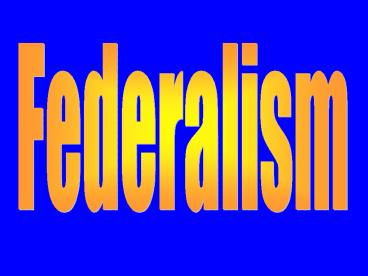Federalism - PowerPoint PPT Presentation
1 / 29
Title:
Federalism
Description:
Article I, Section 8. Article VI, the Supremacy Clause. 10th Amendment. Article IV. Devolution ... Federalism was intended by the Founders to operate as a ... – PowerPoint PPT presentation
Number of Views:74
Avg rating:3.0/5.0
Title: Federalism
1
Federalism
2
Unitary Government National Government - Supreme
3
Confederation States - Supreme
4
Federal Government Shared Power-Federal
Government - Supreme in Some Areas Only
5
John Marshall Chief Justice of Supreme
Court (1801-1835)
6
Marbury vs Madison (1803) Judicial Review
7
McCulloch vs Maryland (1819) necessary and
proper clause
8
Article I, Section 8 Article VI, the Supremacy
Clause 10th Amendment Article IV
9
Devolution
10
Federalism was intended by the Founders to
operate as a protection for personal liberty.
A. True B. False
11
Federalism was intended by the Founders to
operate as a protection for personal liberty.
A. True (Correct
Answer)B. False
12
The doctrine of nullification held that a state
could refuse to enforce within its boundaries a
federal law that exceeded the national
government's authority. A. True B. False
13
The doctrine of nullification held that a state
could refuse to enforce within its boundaries a
federal law that exceeded the national
government's authority. A. True (Correct
Answer) B. False
14
The federal government sometimes finds that the
political limitations on its exercise of power
over the states are greater than the
constitutional limitations. A.True B. False
15
The federal government sometimes finds that the
political limitations on its exercise of power
over the states are greater than the
constitutional limitations. A.True (Correct
Answer) B. False
16
The dollar amount of federal aid to states and
localities increased every year between 1980 and
1994. A. True B. False
17
The dollar amount of federal aid to states and
localities increased every year between 1980 and
1994. A. True B. False (Correct Answer)
18
Most federal mandates, as opposed to conditions
of aid, originate not in Congress but in the
courts. A.True B. False
19
Most federal mandates, as opposed to conditions
of aid, originate not in Congress but in the
courts. A.True (Correct Answer) B. False
20
The national supremacy view of the newly formed
federal government was powerfully defended by
Chief Justice A. John Marshall. B. James
McCulloch. C. John C. Calhoun. D. James Madison.
21
The national supremacy view of the newly formed
federal government was powerfully defended by
Chief Justice A. John Marshall. (Correct
Answer) B. James McCulloch. C. John C.
Calhoun. D. James Madison.
22
After the Civil War the debate about the meaning
of federalism focused on the ______ clause of the
Constitution. A. defense B. tax C. currency D.
commerce
23
After the Civil War the debate about the meaning
of federalism focused on the ______ clause of the
Constitution. A. defense B. tax C. currency D.
commerce (Correct Answer)
24
The U.S. government primarily regulates A.
individual citizens. B. states. C. regions of the
country. D. areas of the world.
25
The U.S. government primarily regulates A.
individual citizens. B. states. (Correct
Answer) C. regions of the country. D. areas of
the world.
26
The standard used to determine when the national
government may exercise powers not specifically
in the Constitution is A.
"necessary and proper." B. "preferred
freedoms." C. "clear and present." D. "mutual
noninterference.
27
The standard used to determine when the national
government may exercise powers not specifically
in the Constitution is A.
"necessary and proper. (Correct Answer) B.
"preferred freedoms." C. "clear and present." D.
"mutual noninterference.
28
All of the following were reasons driving
devolution efforts in the 1990s except A.
deep-seated mistrust of the federal
government. B. concern about the federal budget
deficit. C. lack of flexibility on the part of
the federal government. D. Americans' being in
favor of devolution.
29
All of the following were reasons driving
devolution efforts in the 1990s except A.
deep-seated mistrust of the federal
government. B. concern about the federal budget
deficit. C. lack of flexibility on the part of
the federal government. (Correct Answer) D.
Americans' being in favor of devolution.































